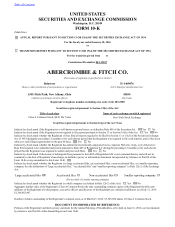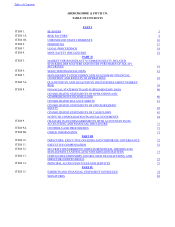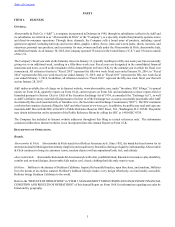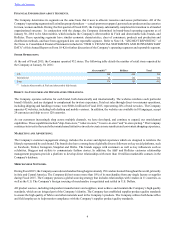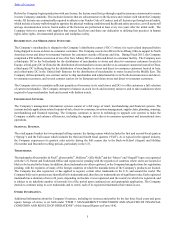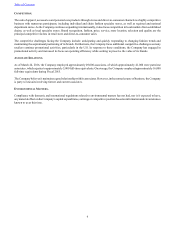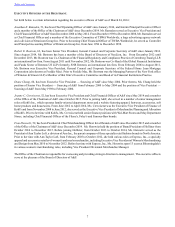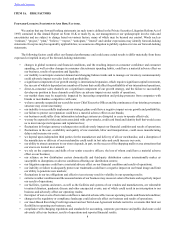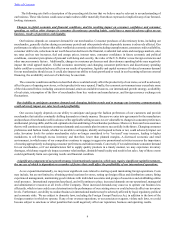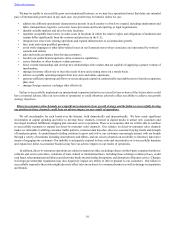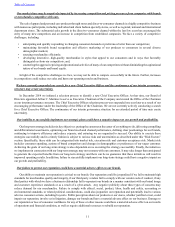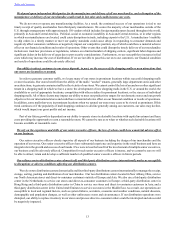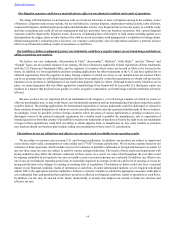Abercrombie & Fitch 2015 Annual Report Download - page 5
Download and view the complete annual report
Please find page 5 of the 2015 Abercrombie & Fitch annual report below. You can navigate through the pages in the report by either clicking on the pages listed below, or by using the keyword search tool below to find specific information within the annual report.
Table of Contents
5
Before the Company begins production with any factory, the factory must first go through a quality assurance assessment to ensure
it meets Company standards. This includes factories that are subcontractors to the factories and vendors with whom the Company
works. All factories are contractually required to adhere to our Vendor Code of Conduct, and all factories go through social audits,
which include a factory walk-through to appraise the physical working conditions and health and safety practices, as well as payroll
and age documentation review. Social audits of the factories are performed at least every two years after the initial audit. The
Company strives to partner with suppliers that respect local laws and share our dedication to utilizing best practices in human
rights, labor rights, environmental practices and workplace safety.
DISTRIBUTION AND MERCHANDISE INVENTORY.
The Company’s merchandise is shipped to the Company’s distribution centers (“DCs”) where it is received and inspected before
being shipped to stores or direct-to-consumer customers. The Company uses its two DCs in New Albany, Ohio to support its North
American stores and direct-to-consumer business for customers outside of Europe and Asia. During Fiscal 2015, the Company
completed a $50 million conversion of one of its New Albany DCs to a dedicated direct-to-consumer facility. The Company uses
a third-party DC in the Netherlands for the distribution of merchandise to stores and direct-to-consumer customers located in
Europe, a third-party DC in China for the distribution of merchandise to stores and direct-to-consumer customers located in China,
a third-party DC in Hong Kong for the distribution of merchandise to stores and direct-to-consumer customers located in Asia,
and a third-party DC in the United Arab Emirates for the distribution of merchandise to stores located in the Middle East. The
Company utilizes primarily one contract carrier to ship merchandise and related materials to its North American stores and direct-
to-consumer customers, and several contract carriers for its European and Asian stores and direct-to-consumer customers.
The Company strives to maintain sufficient quantities of inventory in its retail stores and DCs to offer customers a full selection
of current merchandise. The Company attempts to balance in-stock levels and inventory turnover, and to take markdowns when
required to keep merchandise fresh and current with fashion trends.
INFORMATION SYSTEMS.
The Company’s management information systems consist of a full range of retail, merchandising and financial systems. The
systems include applications related to point-of-sale, direct-to-consumer, inventory management, supply chain, planning, sourcing,
merchandising and financial reporting. The Company continues to invest in technology to upgrade core systems to make the
Company scalable and enhance efficiencies, including the support of its direct-to-consumer operations and international store
operations.
SEASONAL BUSINESS.
The retail apparel market has two principal selling seasons: the Spring season which includes the first and second fiscal quarters
(“Spring”); and the Fall season which includes the third and fourth fiscal quarters (“Fall”). As is typical in the apparel industry,
the Company experiences its greatest sales activity during the Fall season due to the Back-to-School (August) and Holiday
(November and December) selling periods, particularly in the U.S.
TRADEMARKS.
The trademarks Abercrombie & Fitch®, abercrombie®, Hollister®, Gilly Hicks® and the “Moose” and “Seagull” logos are registered
with the U.S. Patent and Trademark Office and registered or pending with the registries of countries where stores are located or
likely to be located in the future. In addition, these trademarks are either registered, or the Company has applications for registration
pending, with the registries of many of the foreign countries in which the manufacturers of the Company’s products are located.
The Company has also registered, or has applied to register, certain other trademarks in the U.S. and around the world. The
Company believes its products are identified by its trademarks and, therefore, its trademarks are of significant value. Each registered
trademark has a duration of ten to 20 years, depending on the date it was registered, and the country in which it is registered, and
is subject to an indefinite number of renewals for a like period upon continued use and appropriate application. The Company
intends to continue using its core trademarks and to renew each of its registered trademarks that remain in use.
OTHER INFORMATION.
Additional information about the Company’s business, including its revenues and profits for the last three fiscal years and gross
square footage of stores, is set forth under “ITEM 7. MANAGEMENT’S DISCUSSION AND ANALYSIS OF FINANCIAL
CONDITION AND RESULTS OF OPERATIONS” of this Annual Report on Form 10-K.

